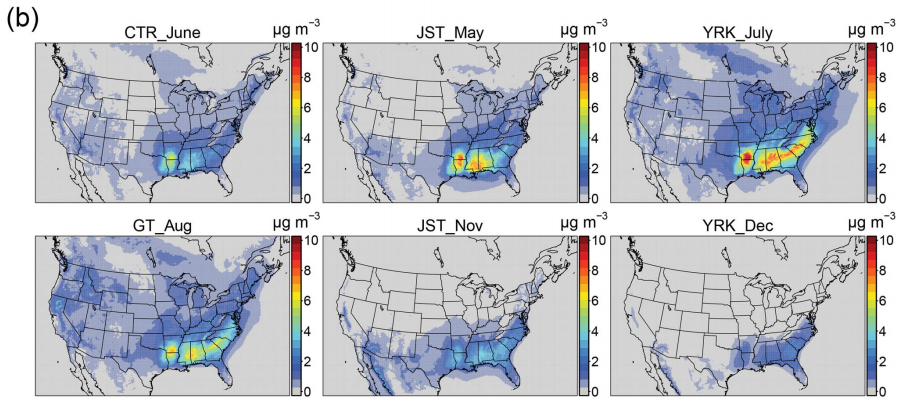Improving the representation of monoterpene chemistry leading to PM2.5 in CMAQ
Organic compounds are an important part of ambient PM2.5 with complex and diverse sources. Measurements of individual species in ambient organic aerosol during the summer of 2013 revealed that oxidation of compounds emitted by vegetation, specifically monoterpenes, are the dominant contributor to summertime organic aerosol in the southeast U.S. (Zhang et al. 2018). Analysis of datasets around the southeast highlight that monoterpene oxidation products are present in PM2.5 throughout the year (Xu et al. 2018). Nitrogen oxides, mostly from anthropogenic combustion, have a variety of effects on ambient organic aerosol with indications that NOx facilitates biogenic PM (e.g. Pye et al. 2015, Liu et al. 2018, Pye et al. 2019).
The CMAQ Aerosol Team at EPA has embarked on two parallel tracks to understand how monoterpene oxidation results in ambient PM2.5. One track focuses on implementation of broad, model-ready aerosol representations. Specifically, in the work of Xu et al. (2018) we implemented a volatility resolved treatment of monoterpene oxidation obtained from laboratory experiments and compared it with observational estimates of ambient monoterpene secondary organic aerosol (SOA). This work dramatically improved the predicted abundance of monoterpene aerosol in comparison to measurements and will be available in CMAQ v5.3 (scheduled for release later in 2019).
 Figure 1: Monoterpene-derived SOA concentration predicted by CMAQ at different times of year. This update will be available in CMAQ v5.3. Reproduced from Figure 6b of Xu et al. (2018) by permission of the authors.The second CMAQ SOA development track creates detailed mechanistic models to inform large-scale patterns and trends. For example, Zhao et al. (2018) constrained autoxidation pathways and RO2+RO2 reactions using laboratory data to reveal that gas-phase dimer production pathways could account for 5-60% of a-pinene SOA. In addition, the work showed that autoxidation, a unique intramolecular reaction that efficiently produces PM, may be 10x faster than previous results. Pye et al. (2019) developed a detailed representation of OH oxidation to show that autoxidation pathways dictate the abundance of SOA from monoterpenes and influences how anthropogenic emissions regulate biogenic SOA (read more under CMAQ Research Highlights). Future work will further develop the mechanistic understandings of the monoterpene system providing a basis for developing condensed, model-ready CMAQ algorithms that accurately reflect how different pollutant mixtures interact.
Figure 1: Monoterpene-derived SOA concentration predicted by CMAQ at different times of year. This update will be available in CMAQ v5.3. Reproduced from Figure 6b of Xu et al. (2018) by permission of the authors.The second CMAQ SOA development track creates detailed mechanistic models to inform large-scale patterns and trends. For example, Zhao et al. (2018) constrained autoxidation pathways and RO2+RO2 reactions using laboratory data to reveal that gas-phase dimer production pathways could account for 5-60% of a-pinene SOA. In addition, the work showed that autoxidation, a unique intramolecular reaction that efficiently produces PM, may be 10x faster than previous results. Pye et al. (2019) developed a detailed representation of OH oxidation to show that autoxidation pathways dictate the abundance of SOA from monoterpenes and influences how anthropogenic emissions regulate biogenic SOA (read more under CMAQ Research Highlights). Future work will further develop the mechanistic understandings of the monoterpene system providing a basis for developing condensed, model-ready CMAQ algorithms that accurately reflect how different pollutant mixtures interact.
References
The following links exit the site ExitLiu, J., Russell, L.M., Ruggeri, G., Takahama, S., Claflin, M.S., Ziemann, P.J., Pye, H.O.T., Murphy, B.N., Xu, L., Ng., N.L., McKinney, K.A., Budisulistiorini, S.H., Bertram, T.H., Nenes, A., Surratt, J.D., Regional similarities and NOx-related increases in biogenic secondary organic aerosol in summertime southeastern U.S., J. Geophys. Res. Atmos., https://doi.org/10.1029/2018JD028491, 2018.
Pye, H. O. T., D’Ambro, E., Lee, B., Schobesberger, S., Takeuchi, M., Zhao, Y., Lopez-Hilfiker, F., Liu, J., Shilling, J., Xing, J., Mathur, R., Middlebrook, A., Liao, J., Welti,A., Graus, M., Warneke, C., de Gouw, J., Holloway, J., Ryerson, T., Pollack, I., Thornton, J. A., Anthropogenic enhancements to production of highly oxygenated molecules from autoxidation. P Natl Acad Sci USA, https://doi.org/10.1073/pnas.1810774116, 2019.
Pye, H. O. T., Luecken, D. J., Xu, L., Boyd, C. M., Ng, N. L., Baker, K., Ayres, B. A., Bash, J. O., Baumann, K., Carter, W. P. L., Edgerton, E., Fry, J. L., Hutzell, W. T., Schwede, D., Shepson, P. B., Modeling the current and future roles of particulate organic nitrates in the southeastern United States, Environ. Sci. Technol., https://pubs.acs.org/doi/abs/10.1021/acs.est.5b03738, 2015.
Xu, L., Pye, H. O. T., He, J., Chen, Y., Murphy, B. N., and Ng, N. L., Experimental and model estimates of the contributions from biogenic monoterpenes and sesquiterpenes to secondary organic aerosol in the southeastern United States, Atmos. Chem. Phys., 18, 12613-12637, https://doi.org/10.5194/acp-18-12613-2018, 2018.
Zhang, H. et al., Monoterpenes are the largest source of summertime organic aerosol in the southeastern United States, Proc. Natl. Acad. Sci. USA, https://doi.org/10.1073/pnas.1717513115, 2018.
Zhao, Y., Thornton, J.A., Pye, H.O.T.: Quantitative constraints on autoxidation and dimer formation from direct probing of monoterpene-derived peroxy radical chemistry, Proc. Natl. Acad. Sci. USA, https://doi.org/10.1073/pnas.1812147115, 2018.
